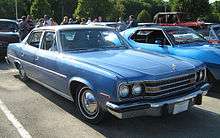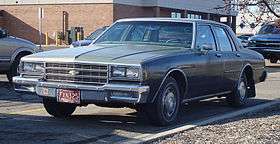Full-size car


A full-size car is a marketing term used in North America for an automobile larger than a mid-size car. Traditional U.S. full-size passenger cars were designed to be comfortable for six occupants and their luggage for long-distance driving. The United States Environmental Protection Agency (EPA) currently uses the term large car to denote full-size cars based on their combined interior passenger and luggage volume.
Definition
.jpg)


The traditional full-size passenger cars that were built by the U.S. automakers (General Motors, Ford, Chrysler, and American Motors) up to the 1970s "can carry six occupants plus vast amounts of luggage over long distances in great comfort, with more than adequate performance, and will give reasonable gas mileage under such conditions."[1]
Full-size cars were also denoted for their length, nearing 4,953 mm (195 in) in basic low-priced, family sedans. The luxury models often tended to reach 5,350 mm (211 in). Previously, a wheelbase greater than 2,794 mm (110 in) was the criterion for full-size. The term first appeared in the early 1960s to distinguish what also became known as "standard"-size cars from the new compact and intermediate models then being introduced. The U.S. EPA defines "large" size as 120 ft³ or more of combined passenger and cargo interior volume in sedans and 160 ft³ or more in station wagons.[2] A majority of U.S. automakers manufactured full size automobiles (with the exception of the Chrysler C platform and AMC's Ambassador) were constructed using a body-on-frame platform. This platform was phased out in 2011 when the Ford Panther vehicles ended production.
Use of the term in North America became popular (and necessary) after the introduction of compacts by the U.S. "Detroit Big Three" for the 1960 model year, and then a few years later the introduction of what became known as mid-size cars. While length and wheelbase varied (increasing over time) being considered full-size required a width as close as practical to the 80 in (2,032 mm) width limit over which the federal government required vehicles to have clearance lights.[3] The term was most correctly applied to cars close to the width limit carrying nameplates of "The Low Priced Three", Chevrolet, Ford, and Plymouth.
Manufacturers hoped their slightly more expensive brands such as Pontiac, Mercury, and Dodge, would be perceived by the public as more desirable than a full-size car even in situations where they were not any larger. However, while the difference between a full-size car, a basic large Chevrolet, Ford, or Plymouth, and a luxury car such as Cadillac, Lincoln, or Imperial, was clear, both manufacturers and consumers had difficulty classifying those in between, such as large Pontiacs, Mercurys, or Dodges. Manufacturers contributed to the lack of distinction by marketing models of their premium brands into the lower price ranges with what had previously been considered medium-priced brands.
For 1977, General Motors downsized its full-size (and higher priced) cars, with overall width cut from approximately 80 in (2,032 mm) to the mid-70 inch range. Chevrolet, Pontiac, and the less expensive Oldsmobile and Buick models had a 116-inch wheelbase. More expensive Oldsmobile and Buick models, plus the Cadillac had a 119 in (3,023 mm) wheelbase, but no more width. The cars sold less well than the 1976 models.[4] Ford and Chrysler downsized for 1979, the latter even building its Chrysler R platform, which was comparable in size to the new platforms designed by GM and Ford. By this time, a huge increase in gasoline prices had made it difficult to sell any large cars, downsized or not. Chrysler had the huge misfortune of introducing two consecutive new designs of its largest cars, in 1974 and 1979, during times when gasoline prices suddenly increased.
The EPA interior and trunk volume categories for the most part resulted in mid-size, full-size, and luxury cars common in the mid-1970s all being classified as large cars. The 1980s Chrysler M platform, classified as large cars at the time, were derived from the Dodge Aspen and Plymouth Volare, originally marketed as compacts.
While many modern cars are referred to as full-size, they do not qualify for the term as used in the 1960s and 1970s. Consumer acceptance of large SUVs approaching 80 inches in width shows interest remains in vehicles capable of three-across seating with reasonable comfort, a strong point of a true full-size car.
Police cars in the United States are almost always full-size cars, such as the Ford Crown Victoria. This is usually due to the amount of interior space for an arrestee as well as trunk volume for computer and electrical equipment. Interior space and trunk volume also make such vehicles popular for taxi use. Since the discontinuation of the Ford Crown Victoria Police Interceptor the de facto replacement has been a variation of the Ford Taurus. Also used is the Chevrolet Tahoe since it is a body-on-frame SUV.
Decline and renaissance


The sales of full-size vehicles in the United States declined after the early 1970s fuel crisis. By that time, full-size cars had grown to wheelbases of 121–127 inches (3.1–3.2 m) and overall lengths of around 225 in (5,715 mm). In the 1970s, due to the fuel crisis and the resulting rise in fuel costs, many people traded in their full-size cars for smaller models such as the Chevrolet Nova, Ford Maverick, and Plymouth Valiant, also it was during this time small Japanese cars such as the Toyota Corolla and Honda Civic gained popularity. American Motors discontinued its full-size 122-inch (3,099 mm) wheelbase AMC Ambassador in 1974[5] and starting in the late-1970s, the other American automakers began selling full-size cars with smaller exterior dimensions and smaller, more fuel efficient engines. That, combined with gas being cheap once again in the late-1980s, full-size cars regained popularity.
Chrysler discontinued its full-size cars (Dodge St. Regis, Chrysler Newport and New Yorker, Plymouth Gran Fury) in 1981 (it continued to produce its midsize M-bodies (Dodge Diplomat, Chrysler Fifth Avenue, and Plymouth Gran Fury) to the 1989 model year). With full-size cars only 8.3 percent of sales in 1994 compared to 65 percent in 1960[6] General Motors discontinued some of its full-size cars (Chevrolet Impala SS/Chevrolet Caprice, Buick Roadmaster, Oldsmobile Ninety-Eight, and Cadillac Fleetwood) in 1996. Buick still had Park Avenue and LeSabre, Oldsmobile had the Regency and the Eighty-Eight, and Cadillac still had the DeVille. Oldsmobile discontinued full-size cars in 1999, and Buick and Cadillac introduced the Lucerne and DTS, respectively, in 2006. The 2011 model year was the final year of production of the Ford Panther platform (the Ford Crown Victoria/Ford Police Interceptor, Mercury Grand Marquis, and Lincoln Town Car), as well as the Lucerne.
During the 1980s and 1990s, full-size cars lost ground to other vehicle types as family vehicles. Initially, full-size sedans and station wagons lost ground to vans, which offered additional seating and cargo capacity with lower fuel consumption. During the 1990s, full-size sedans and wagons lost further ground to mid-size and full-size SUVs, as they had similar towing capacity and a V8 engine started becoming an option in mid-size versions. In North America, full-size station wagons would vanish during the 1990s; Ford was the first to discontinue theirs after the 1991 model year, with GM following suit after 1996.
As fuel costs increase, more consumers select more efficient vehicles. These include automobiles such as compact and mid-size vehicles powered by smaller, more efficient engines. American-brand full-size sedans such as Buicks, and luxury full-size Cadillac DTS are still best-selling in the full-size segment. However, there is a serious attack on full-size by automakers to replace the size with price range. For example, a review by USA News, named "Best luxury large cars of 2008" included only one large car (Cadillac DTS) while the others are mid-size cars. This is mostly because, in Europe, full-size cars only exist as absolute luxury cars (F segment). In 2010, less than a half percent of the new cars sold in Germany fit into this category.[7] In other European countries, even the D- and E segments (making together the equivalent to U.S. mid-size cars) are not common.
_sedan_(2010-07-19)_01.jpg)
Outside North America
_G6E_Turbo_sedan_(2016-01-29)_01.jpg)
A "large family car," the equivalent of a full-size car class in Australian terms, is often denoted by width. Therefore, the Ford Falcon, Toyota Aurion, and Holden Commodore are considered large cars in the Australian and New Zealand markets. These cars are sometimes referred to as "family cars" in Australia, and are typically 4,800 mm (189 in) or more in length.
In the United Kingdom and Ireland, the terms "executive car" and "luxury car" may refer to cars of this size. In fact, an "executive car" also means a car which is more expensive than a large family car, but cheaper than a mid-size luxury car.
See also
References
- ↑ Norbye, Jan; Dunne, Jim (February 1974). "Is there still a place for FULL-SIZE cars?". Popular Science. 204 (2): 24, 26, 30, 34, and 35. Retrieved 6 January 2014.
- ↑ "Frequently Asked Questions: How are vehicle size classes defined?". fueleconomy.gov (U.S. Department of Energy). Retrieved 7 June 2016. Click "How are vehicle size classes defined?"
- ↑ "Federal Motor Carrier Safety Administration Lamps and Reflective Devices".
- ↑ Flammang, James M. (2000). Standard Catalog Of American Cars 1976-1985. Krause Publications. ISBN 9780873411134.
- ↑ Cranswick, Marc (2001). "AMC's Final Full-Size - Ambassador - 1967-74". Cars of American Motors: An Illustrated History. McFarland. pp. 167–176. ISBN 978-0-7864-4672-8. Retrieved 6 January 2014.
- ↑ Jedlicka, Dan (May 1, 1995). "American Tradition is Still Around - The Big Car lives". Chicago Sun-Times. p. Auto Times 1.
- ↑ "Pkw-Neuzulassungen im Jahr 2010" (in German). Heise.de. 7 January 2011. Retrieved 6 January 2014.
External links
- Official US government car size class definitions
- use of "large cars" in "Best Luxury Large Cars 2008 from USA News